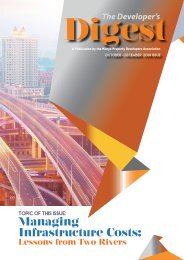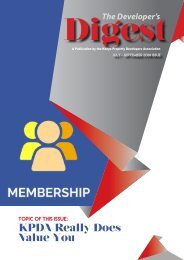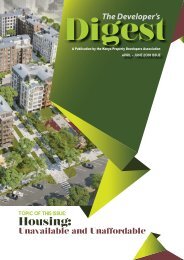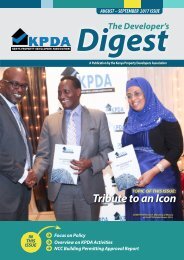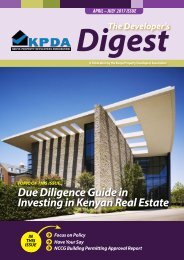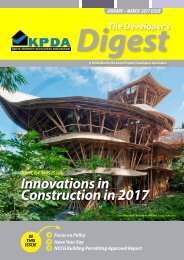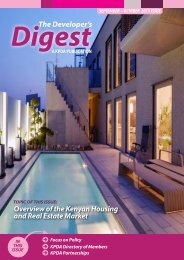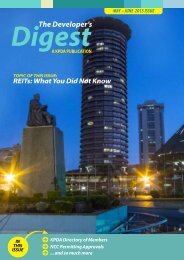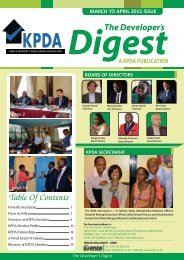The Developer's Digest, Jan - Mar 2018 Issue
Create successful ePaper yourself
Turn your PDF publications into a flip-book with our unique Google optimized e-Paper software.
25<br />
26<br />
from KPDA Partner<br />
from KPDA Partner<br />
align leadership, improve cross-sector collaboration, and build new models of inclusive governance to drive<br />
effective planning and project delivery.<br />
Cities now contribute to a vast and growing equity gap. Globally, a number of complex issues are<br />
colliding: income, education, and health disparities that sit at the root of social unrest; blight and ecological<br />
degradation; and the growing threat of climate change. Neighborhoods are the Soul & Lifeblood of the city.<br />
Sustainability Needs<br />
To Be Scaled From A<br />
Neighbourhood Level<br />
It has been a tradition in Kenya for developers to Master plan their development projects into gated<br />
communities and mixed-use developments-a recent phenomenal. Gated communities convey a sense of<br />
place and social exclusivity, perceptions the developers have capitalized on to fuel their greatest desire at<br />
this point which is to sell as many units as possible in the development and as fast as possible in order to<br />
move on to the next project development and so on.<br />
Now, when you take Nairobi as a benchmark and sift through property marketing material, you will notice the<br />
prominence of exclusivity in addition other unique selling features like security, internet & cable connectivity,<br />
sense of place, green infrastructure and sustainability features. This was not the case some years ago.<br />
<strong>The</strong>se selling propositions are an improvement to overcome deficiencies that have seen yesteryear flagship<br />
estates like Buruburu and Woodley end up in premature decay. Although property values have gone up with<br />
time in these neighbourhoods for example, these values have failed to reflect the true picture of what would<br />
have been their actual values at this point in time.<br />
As developers continue to build houses to cater for the housing deficit that currently plaques Kenya, they<br />
will have to integrate sustainability from a neighbourhood scale. Sustainability and resilience are becoming<br />
major drivers of property investment decision because of their ability to future proof real estate investments.<br />
With hundreds of millions of people moving into cities worldwide and trillions of shillings being spent to<br />
accommodate this growth over the next 30 years, Developers and investors should see this as a major<br />
opportunity to promote a range of neighborhood-scale sustainability best practices that simultaneously<br />
address equity, resilience, and climate protection.<br />
In order for sustainable neighbourhood to thrive, developers will have to look beyond the physical<br />
environment. <strong>The</strong>y will have to look at the people who live around their neighbourhood developments<br />
and those who will live in those upcoming neighbourhoods under their development. This will mean doing<br />
more than just having a facilities or property management company on board. Rather, it will necessitate<br />
establishing community engagement and governance structure for a development that will be able to<br />
address equity, resilience and climate protection. Developers will have to embrace and incorporate new<br />
models of urban regeneration to empower just, resilient, sustainable neighborhoods for all.<br />
This is because, for far too long, urban regeneration has been primarily about brick-and-mortar solutions<br />
to building and rehabilitating neighborhoods. <strong>The</strong> world of city building has drastically changed, and it<br />
requires a more diverse and more integrated range of solutions to empower social vibrancy and<br />
restore ecological health. Success hinges on building robust public-private-civic partnerships to<br />
Neighborhoods sit at the heart of some of the most complex challenges facing city makers today. But they<br />
can also become the building blocks of sustainable cities. Neighborhoods provide a uniquely valuable scale<br />
to introduce and accelerate investments that can achieve profound improvements in equity, resilience, and<br />
climate protection. Neighborhoods are the right scale to accelerate sustainability because they are small<br />
enough to innovate and big enough to leverage meaningful investment and public policy impact. How we<br />
build our cities — from the neighborhood up — is the biggest challenge of our lifetime.<br />
To foster this new model and era of urban regeneration and property development, developers will have<br />
to accept a new rigorous sustainable urban development framework for achieving people-centered,<br />
economically vibrant, planet-loving, neighborhood- and district-scale sustainability. Such a<br />
framework puts a comprehensive lens on every urban regeneration decision, drives the delivery of<br />
meaningful performance outcomes, and sets the conditions for sustainable, collective impact.<br />
Towards Real Estate Development that is Value Driven, Sustainable and Socially Responsible<br />
Towards Real Estate Development that is Value Driven, Sustainable and Socially Responsible








